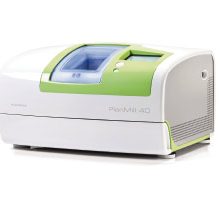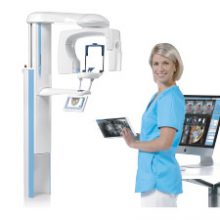Cone beam computed tomography (CBCT) imaging is becoming the new standard of care for complete patient information. These images provide multifaceted views of teeth and everything below the gum line, including the mandibular nerve canal, making them invaluable tools for planning implant cases and other restorative treatments.

The Planmeca PlanMill 40 is just one component of the Planmeca FIT CAD/CAM technology, expanding a practice’s ability to offer same-day dentistry, an in-demand service valued by a growing number of patients.
Now, consider combining this detailed information below the gum line with images from an intraoral scan, capable of capturing the highest resolution of data above the gum line. This combination of CBCT DICOM data and STL data from CAD/CAM sources gives doctors the ability to provide the required information and tissue leveling for a crown-down implant plan. In most cases, the STL data can also be utilized by the lab to create the final surgical guide for placing the implant with unparalleled accuracy and speed. Temporary and final restorative crowns can be milled in-office in a matter of minutes or milled by a lab in as little as 24 hours.
Planmeca has harnessed this technology with the ProMax 3D family of imaging units and the Planmeca FIT system (CAD/CAM), offering doctors the ability to capture a data set with more detail than ever.
Streamlining the Digital Workflow
Digital dentistry is streamlining virtually every aspect of the restorative workflow. Traditionally, doctors submit a physical impression to the lab with the prescription and instructions written out on paper. This is gradually ceding ground to an entirely digital process where the patient’s information and doctor’s instructions are sent to the lab electronically via a digital impression system. Planmeca PlanScan restorations can be delivered mere days after the laboratory receives the patient’s intraoral scans, and the capabilities of in-office milling units, such as the Planmeca PlanMill 40, are making same-day dentistry a reality. The restorations produced by the Planmeca FIT system, using digital impressions and CBCT scans, reduce the costs and treatment time associated with replacing a tooth, increasing the demand for digital dentistry exponentially.

Planmeca imaging and CAD/CAM solutions work seamlessly with a variety of dental technologies to deliver a completely digital workflow, whether restorations are milled in-house or at an outside laboratory.
For those who still want to work with their labs, all of the patient information needed to produce a model-less restoration can be submitted digitally to a dental laboratory. Clinicians enter the patient’s information and prescription data into their digital impression system’s software prior to submitting each case. Because the Planmeca FIT system is an open system and the dental team can send the file in a standard STL format, exchanging patient data is easy between most systems through Planmeca Romexis software.
Maximizing Practice Profitability with Open Architecture
Data standardization is essential to driving down costs for patients, doctors, and laboratories alike by establishing interoperability between intraoral scanners, CAD/CAM software, and other dental systems. Ultimately, having a common standard that allows the disparate systems used in dental care to function as plug-and-play devices rather than requiring pricey IT solutions will reduce the costs of integrating these new technologies into dental practices and maximize the ROI of the equipment. Planmeca imaging and CAD/CAM, along with Planmeca Romexis digital treatment-planning software, are using this idea to improve the efficiency, predictability, and cost-effectiveness of dental restorations, making chairside dentistry a lucrative investment for dentists who wish to grow their practice and offer patients the latest in same-day technology.
